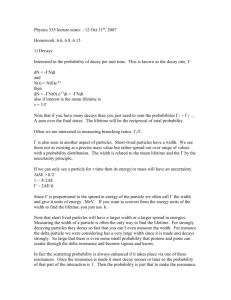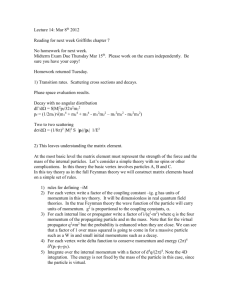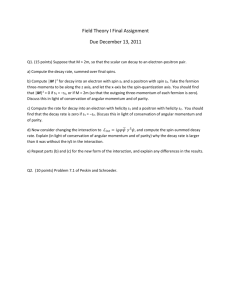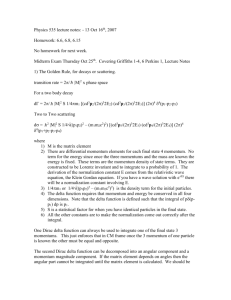lecturenotes2012_13
advertisement
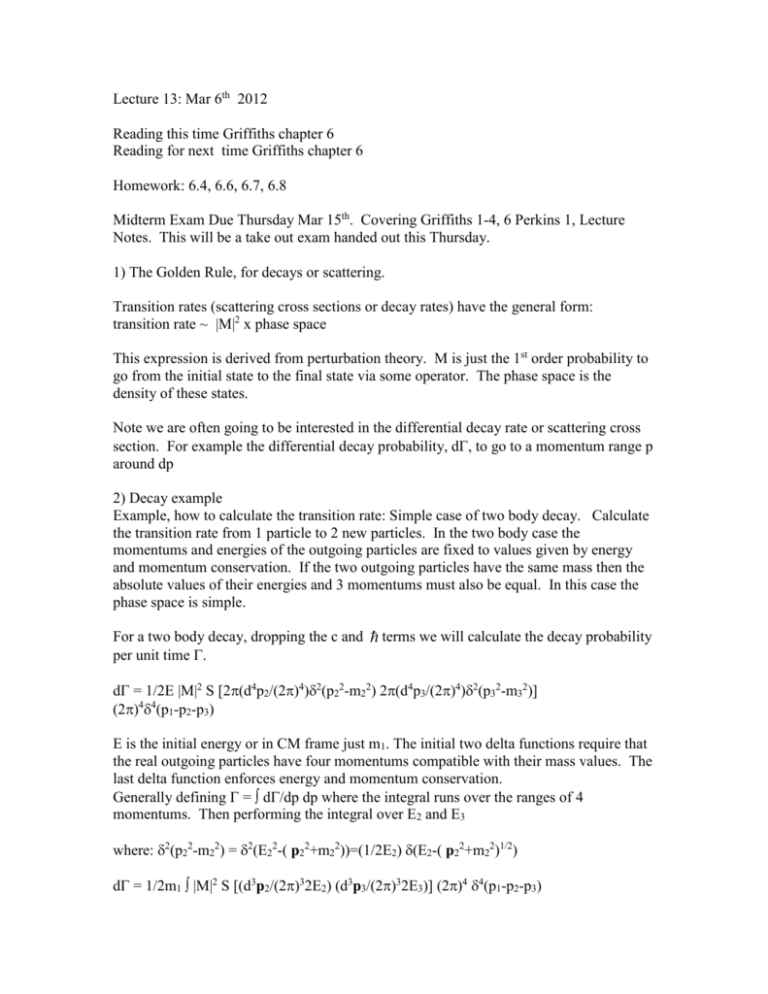
Lecture 13: Mar 6th 2012 Reading this time Griffiths chapter 6 Reading for next time Griffiths chapter 6 Homework: 6.4, 6.6, 6.7, 6.8 Midterm Exam Due Thursday Mar 15th. Covering Griffiths 1-4, 6 Perkins 1, Lecture Notes. This will be a take out exam handed out this Thursday. 1) The Golden Rule, for decays or scattering. Transition rates (scattering cross sections or decay rates) have the general form: transition rate ~ |M|2 x phase space This expression is derived from perturbation theory. M is just the 1st order probability to go from the initial state to the final state via some operator. The phase space is the density of these states. Note we are often going to be interested in the differential decay rate or scattering cross section. For example the differential decay probability, d, to go to a momentum range p around dp 2) Decay example Example, how to calculate the transition rate: Simple case of two body decay. Calculate the transition rate from 1 particle to 2 new particles. In the two body case the momentums and energies of the outgoing particles are fixed to values given by energy and momentum conservation. If the two outgoing particles have the same mass then the absolute values of their energies and 3 momentums must also be equal. In this case the phase space is simple. For a two body decay, dropping the c and per unit time . terms we will calculate the decay probability d = 1/2E |M|2 S [2(d4p2/(2)4)2(p22-m22) 2(d4p3/(2)4)2(p32-m32)] (2)44(p1-p2-p3) E is the initial energy or in CM frame just m1. The initial two delta functions require that the real outgoing particles have four momentums compatible with their mass values. The last delta function enforces energy and momentum conservation. Generally defining = d/dp dp where the integral runs over the ranges of 4 momentums. Then performing the integral over E2 and E3 where: 2(p22-m22) = 2(E22-( p22+m22))=(1/2E2) (E2-( p22+m22)1/2) d = 1/2m1 |M|2 S [(d3p2/(2)32E2) (d3p3/(2)32E3)] (2)4 4(p1-p2-p3) where 1) M, the matrix element, will quantify the dynamics of the interaction 2) There are differential momentum elements for each 3 momentum. No term for the energy since once the three momentums and the mass of the particle are known the energy is fixed and we integrated them out using the delta function. 3) m1, the mass of the original particle, is the natural scale of the problem. 1/2m1 is known as a density of states term for the initial particle where E=m1. Note that 1/2E terms exist for the two final state particles as well where they came our of the delta function where possibilities for the energy of the final state particles were defined. Technically we could have defined a delta function for the initial state which would have extracted the 1/2m term. The integral over the initial 3 momentum would be trivial since they are all 0. 4) The remaining delta function requires that momentum and energy be conserved in all four dimensions. 5) All the other terms are to make the normalization and units come out correctly after the integral 6) S is a statistical factor for when you have identical particle in the final state. 1/n! for each set of n identical particles. Example of two massless particles: E2 = E3 = |p2| = |p3|, -p2 = p3 = (1/2m1) |M|2 S [(d3p2/(2)32E2) (d3p3/(2)32E3)] (2)4 4(p1-p2-p3) = (S/8m1)1/(2)2 |M|2/(|p2||p3|) d3p2 d3p3 3(-p2-p3) (m - E2 - E3) Integrating over p3 and the 3D delta function which just fixes it’s value to -p2. = (S/8m1) 1/(2)2 |M|2/|p2|2 d3p2 (m - E2 - E3) Note that there are two cases here depending on weather the physics of M will result in an angular distribution. 1) We expect no angular distribution and M has no dependence on the phi or theta of particle 2. Therefore it’s only a function of |p2|. 2) There is angular distribution. This will depend on the spins and the force involved. For instance we saw in the decay of Co 60 there is a definite angular distribution to the decay. If there is an angular function and we have to understand M before proceeding. Let’s consider case 1. Often we will integrate over all the remaining momentum factors for a decay. Switch to spherical coordinates and integrate of phi and theta, which will give us 4. d3p2 = |p2|2 d|p2| sin d d = (S/8m1) 1/(2)2 4 |M|2 d|p2| (m - E2 - E3) = (S/8m1) 1/(2)2 4 |M|2 d|p2| (m - 2|p2|) We need the delta function in terms of |p2|. Look up identities in appendix. = (S/8m1)M|2 d|p2| (1/2)((1/2)m - |p2|) = (S/16m1)|M|2 d|p2| ((1/2)m - |p2|) Integrating over the last delta function. = (S/16m1)|M|2 where M is evaluated at the momentum given by the conservation laws. M should be proportional to momentum squared. Result of general case with masses later 3) Two to Two scattering The Golden Rule, for decays or scattering. transition rate ~ |M|2 x phase space For a two body decay d = |M|2 S 1/2m1 [(d3p2/(2)32E2) (d3p3/(2)32E3)] (2)4 4(p1-p2-p3) Two to Two scattering d = |M|2S 1/4((p1p2)2 – (m1m2)2)[(d3p3/(2)32E3)(d3p4/(2)32E4)](2)44(p1+p2-p3-p4) where 1) M, the matrix element, will quantify the dynamics of the interaction 2) There are differential momentum elements for each 3 momentum. No term for the energy since once the three momentums and the mass of the particle are known the energy is fixed and we were able to integrate them out using the delta function. 3) 1/2m1 or 1/4((p1p2)2 – (m1m2c2)2) is the density term for the initial particles. m1, the mass of the original particle, is the natural scale of a decay problem. 4) The remaining delta function requires that momentum and energy be conserved in all four dimensions. 5) All the other terms are to make the normalization and units come out correctly after the integral. 6) S is a statistical factor for when you have identical particle in the final state. 1/n! for each set of n identical particles. In CM frame p1 = -p2 and ((p1p2)2 – (m1m2)2) = 1/(E1+E2)|p1|, homework problem 6.7 The Dirac delta function can be broken in energy and momentum components. One Dirac delta function can always be used to integrate one of the final state 3 momentums. This just enforces that in CM frame once the 3 momentum of one particle is known the other must be equal and opposite. The second Dirac delta function can be expressed as momentum magnitude function or and energy function as convenient for integrating the problem. The remaining integral can be as a momentum magnitude component and an angular component. If the matrix element depends on angles then the angular part cannot be integrated until the matrix element is calculated. We should be able to integrate the momentum magnitude part, though a change of variables or reformulation of the delta function is often necessary . = (S/(642(E1+E2)|p1|) |M|2/(E3E4) d3p3 d3p4 3(p1-p2-p3-p4) (E1+E2 – E3 – E4) = (S/(642(E1+E2)|p1|) |M|2/(E3E4) d3p3 (E1+E2 – E3 – E4) d/d = (S/(642(E1+E2)|p1|) |M|2/(E3E4) | p3|2d|p3|(E1+E2 – E3 – E4) d/d = (1/8)2 |M|2 S |pf|/|pi| 1/E2 4) Transition rates. Scattering cross sections and decays. Phase space evaluation results. Decay to massless particles with no angular distribution = (S/16m1)|M|2 Decay with no angular distribution = S|M|2pf/8m12 pf = (1/2m1)(m14 + m24 + m34 - m12m22 – m12m32 - m22m32) Two to two scattering d/d = (1/8)2 |M|2 S |pf|/|pi| 1/E2 No angular distribution = (1/16) |M|2 S |pf|/|pi| 1/E2 5) This leaves understanding the matrix element. At the most basic level the matrix element must represent the strength of the force and the mass of the internal particles. Let’s consider a simple theory with no spins or other complications. In this theory the basic vertex involves particles A, B and C. In this toy theory as in the full Feynman theory we will construct matrix elements based on a simple set of rules. 1) rules for defining –iM 2) For each vertex write a factor of the coupling constant –ig. g has units of momentum in this toy theory. It will be dimensionless in real quantum field theories. In the true Feynman theory the wave function of the particle will carry units of momentum. g2 is proportional to the coupling constants, . 3) For each internal line or propagator write a factor of i/(q2-m2) where q is the four momentum of the propagating particle and m the mass. Note that for the virtual propagator q2m2 but the probability is enhanced when they are close. We can see that a factor of 1 over mass squared is going to come in for a massive particle such as a W in and small initial momentums such as a decay. 4) For each vertex write delta function to conserve momentum and energy (2)4 4(p1-p2-p3). 5) Integrate over the internal momentum with a factor of d4q/(2)4. Note the 4D integration. The energy is not fixed by the mass of the particle in this case, since the particle is virtual. 6) The first step will be to cancel out delta functions by performing an integral over the internal momentum. There will a final delta function will state overall conservation of momentum and energy. Remove this factor since it was already used in evaluating the overall transition rate. 3) Lets treat decay as a simple one vertex process A B+C. No propagator. For a simple one vertex process. -iM = [-ig] (2)4 4(pA-pB-pC) remove the final delta function to preserve momentum and energy since it was already stated in the transition rate. M=g g2 1/g2 Then = (S|p2|/8m12)|M|2 = (|p2|/8m12)g2 = 8m12/(|p2|g2) Taking m, p and g in MeV. is in units of Mev, in units of 1/MeV and we have to multiply by = 6.582x10-22 MeVs to extract the lifetime in seconds. Note. In EM theory g can be identified with , g = (4) For this decay the other side of the diagram is governed by the details of the bound state, but to first approximation the bound particles are always interacting at high probability so that side of the decay happens with a probability of 1. 4) Weak decay The weak decay cannot be represented as a one vertex interaction since the probability of the bound state interacting via the weak force is small. For instance for a meson to decay it must be considered as a two to two process with the quark and anti-quark of the meson annihilating each other and then the weak boson pair producing a lepton and antineutrino. For this process the phase space will just be the phase space for one to two decay, meson to lepton and antineutrino but the Matrix element must be calculated as a two to two process. The toy theory is not rich enough to properly treat the bound state but this will give us an estimate of true weak lifetimes. Note that due to the details of the bound states weak lifetimes can vary by many orders of magnitude. Consider pion decay to a electron and antineutrino. The masses of the electron and the neutrino are small enough that they can be neglected. ~ |M|2/16m1 For the matrix element consider the simple two vertex annihilation process A+B A+B mediated by C with momentum q. -iM = [-ig] [i/(q2-m2)] [-ig] [1/(d4q/(2)4)] [(2)4 4(p1+p2-q)] [(2)4 4(q-p3-p4)] Integrate over one delta function -iM = [-ig] [i/((p1+p2)2-m2)] [-ig] (2)4 4(p1+p2-p3-p4)] remove the second delta function M = g2[1/((p1+p2)2-m2)] Take the case where mW is large and we recover expected form of coupling constant for the weak force. M ~ g2/mw2 ~ (g2/mW2)2/16m1 where anticipating electroweak unification g is identified with the EM g = (4) ~ (/mW2)2/m1 ~ W2/m1 Note again that the units don’t work out in our toy model unless you give our coupling constant new coupling constant dimensions of MeV. Invert and multiply by W = 10-5 = 6.582x10-22 MeVs to get the lifetime m1 = m = 139.6 MeV Therefore = 2.250x10-12 MeV: very small so we expect a relatively long lifetime = / = 2.925x10-10 sec Fairly similar to what we will eventually get for the weak force for pion decay to electron and anti electron neutrino, though not surprising that it’s a few orders of magnitude off the real value.
